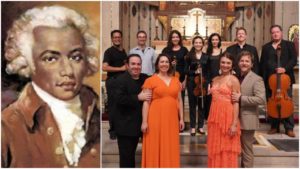
Restoring a Classic – How Opera Ritrovata Created a Critical Edition for Joseph Bologne’s ‘L’Amant Anonyme’
By David SalazarBack in the 18th century, Joseph Bologne, Chevalier de Saint-Georges was one of the great figures of his day.
He was a notable composer, violinst, and famed swordsman, with even Mozart having had great admiration for his talents.
But a racist history would conspire to ultimately send him and his work into relative obscurity to the point that today, only one of several operas composed by Bologne is accessible to the general public.
Recent tragedies and questions about racial equity around all facets of social life have brought the focus back on major Black figures, with the world of classical music specifically seeking to spotlight the long-ignored works of Black composers.
Bologne, like many other Black composers, became a part of a conversation that he had long been locked out of.
And while “L’Amant Anonyme,” his lone opera, has gotten performances in recent years (most notably championed by Marlon Daniel, the first conductor to lead a performance of the opera in 230 years and also the founder of the Festival International de Music Saint-Georges), the work is about to get an added boost when it appears at the Los Angeles Opera on Nov. 14, 2020, as part of the organization’s online season.
This will be the company’s first production of the work and also the first of the new critical edition by Opera Ritrovata, an organization that aims to recover and promote the music of composers whose voices were suppressed due to issues such as gender or race.
A Critical Edition
LA Opera had already been in the process of investigating the possibilities of taking on the opera when they came across Opera Ritrovata’s recordings of a few arias and scenes from Bologne’s work.
Opera Ritrovata had been working on the critical edition for several years at that point, but the official commission from the LA Opera revved up the process significantly.
“The process of restoring ‘L’Amant Anonyme’ to a modern performance edition was both intellectually rewarding and stimulating,” violinist Mishkar Núñez-Fredell, a founding member of Opera Ritrovata and its Coordinator for Historically Informed Performance Practice, told OperaWire. “Our team of four engravers and editors meticulously reviewed the manuscript, deciphering its form and structure, analyzing its harmonies, enveloping ourselves in its melodic material and reveling in the intimacies of the antiquated French verbiage.”
Each of the editors worked through each scene several times and engaged in discussions about intentions, both musically and notionally.
Núñez-Fredell noted that the manuscript was littered with inconsistencies with regards to phrasing, articulation, and dynamic markings.
And then there were challenges of finding a balance between 18th-century style and modern performance practice, particularly with the libretto.
“Our original intention regarding the libretto had been to preserve the antiquated spelling scheme, but as we spent more time with the text, we reconsidered and chose to present the score with a thoroughly modernized text,” Núñez-Fredell added. “This was all in accord with our desire to present an edition without unnecessary obstacles for performing artists. In the spirit of transparency, we produced a libretto which tracks each individual correction or modernization we have made to the text.”
A Very Modern Opera
According to Núñez-Fredell, what made the opera so attractive as one of Opera Ritrovata’s first major projects the complexity of the work.
The plot by Madame de Genlis, which concerns a powerful, fully independent woman making healthy relationship choices, in an odd way is quite unique in the history of opera,” Núñez-Fredell noted, adding that the opera arrived 50 years before Donizetti’s “L’Elisir d’Amore, “which is the earliest opera people tend to think of where a female protagonist’s good fortune is not due to any man in the opera. Much like Léontine ‘rescues’ Valcour from his lower status, Adina rescues Nemorino from a poorly-considered decision to join the army when he needed money.”
Musically, these internal struggles of the heroine are communicated through “beautiful, long melodic lines and interesting harmonic and rhetorical devices,” Núñez-Fredell added, spotlighting the trio in Act II, scène v “which features literal trembling in the strings as the singer declaims her shivers. This trio paints a picture of the couple realizing their happiness, but still being overwhelmed by anxiety and emotion before the elation actually hits them.”
Núñez-Fredell also noted that the opera is full of musical innovation for Bologne’s day.
“He was at the forefront of musical advancement it seems or he simply couldn’t resist having more notes at his disposal, such the D above middle C in the natural horns, that were made possible by very recent developments in wind instrument technique just before the valve was invented in the early 19th century,” he noted. “If there is one feature we think pervades the entire opera, it would be the incredible energy Saint-Georges brings to the music. Every number is written with an incredible sense of optimism, bravura, and high spirits.”
With the new critical edition, Núñez-Fredell hopes more opera companies like the LA Opera will take on the challenge of reintroducing “L’Amant Anonyme” into the operatic canon.
“There is so much to appreciate about ‘L’Amant Anonyme: the intrigue of the love story, the well-rounded and independent female protagonist, the excellent music, even the approachable length,” Núñez-Fredell summarized. “Bologne had essentially reached the highest successes possible for any musician in Paris, and had done so as a Black man from a French colony in a highly stratified society where his race was a major count against him. Only an extraordinary performer would have won a position in the Concert des Amateurs, and only the most extraordinary member of that organization (who would have had to be a great composer and conductor as well) would have risen to the leadership position.
“This opera shows his skill as a composer in full force: memorable tunes, intriguing harmonies, skillful writing, especially for the voice and strings. We also think the audience will appreciate the reality of the human emotion, which never overwhelms the overall lightheartedness of the comedy.”


